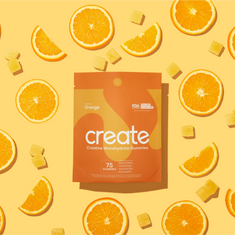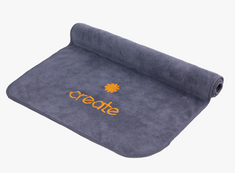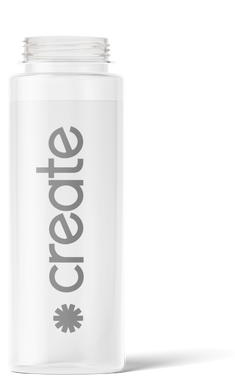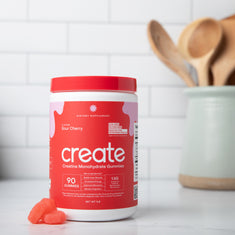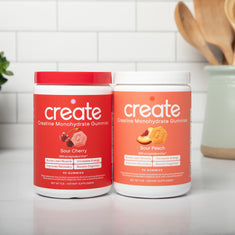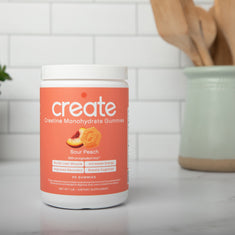Is Creatine Good For Calisthenics?
In the world of calisthenics, the journey from mastering basic movements to achieving brilliance in advanced exercises is a testament to dedication and hard work. Amid this pursuit of strength, skill, and perfection, a question arises: Could creatine be the missing link that propels calisthenics enthusiasts toward their goals?
Creatine, a well-known supplement in the fitness realm, has garnered attention for its potential to enhance performance and aid in recovery. As we explore the synergy between creatine supplementation and calisthenics progression, we delve into the science behind this supplement and its implications for those striving to excel in bodyweight training.
For those intrigued by the possibilities, Create is offering creatine supplementation, aiming to provide the support needed to elevate your calisthenics journey to new heights.
Understanding Calisthenics And Its Demands
Using just one's own body weight as resistance, calisthenics aims to improve one's strength, flexibility, endurance, and general well-being. Calisthenics is a kind of exercise that emphasizes using only one's own body weight and gravity as resistance, as opposed to standard weightlifting, which makes use of external weights. Because of its adaptability, this kind of training is often used for both indoor and outdoor sessions.
Bodyweight Training For Strength And Skill
Calisthenics exercises range from simple to complex, testing both your strength and your ability to perform complex motions with precision. Push-ups, pull-ups, squats, dips, handstands, muscle-ups, and other bodyweight exercises performed on parallel bars or rings are all examples of popular calisthenics. These routines call for more than just power; they also call for command, stability, and coordination. One-arm push-ups, one-arm pull-ups, and handstand push-ups are just a few examples of more complex varieties that require practice.
Emphasis On Functional Fitness
Calisthenics is a kind of exercise that emphasizes functional fitness by simulating everyday movements. The workouts are designed to improve functional strength and agility by simulating real-world motions. Since many calisthenics exercises feature explosive motions, this is in line with creatine's potential advantages for increasing power and explosiveness during brief bursts of intensive activity.
Creatine's Role In Energy Production
Creatine is essential for energy production. This supplement is popular among athletes and bodybuilders for muscle growth and performance. Creatine supplements can improve the body's natural phosphocreatine, which powers rapid, intensive motions like calisthenics. Below are a few of creatine's effects on calisthenics performance:
ATP Regeneration And Immediate Energy Source
Calisthenics movements often require quick bursts of energy, and creatine's role in regenerating ATP aligns perfectly with this requirement. The swift restoration of ATP allows individuals to maintain the intensity of explosive movements like jumps, muscle-ups, and dynamic transitions.
Phosphocreatine And Rapid Energy Resupply
Muscle phosphocreatine reserves are a major factor in the efficient regeneration of adenosine triphosphate (ATP). As a result, this method guarantees a rapid and considerable energy supply for brief, concentrated tasks. Because of the importance of speed and power in calisthenics, phosphocreatine plays a pivotal role in allowing athletes to perform explosive exercises to their full potential.
Enhancing Anaerobic Performance
As many calisthenics routines rely on anaerobic pathways, creatine's effect on ATP regeneration offers a useful performance boost. Creatine aids the anaerobic energy systems, making it more effective for activities like muscle-ups, jumps, and dynamic transitions that need short, powerful bursts of energy.
Bridging The Energy Gap
Creatine bridges the gap between short-term energy stores like ATP and long-term energy systems. This connecting effect is especially useful during calisthenics sets, where the need for energy tends to rise and fall. It aids in maintaining performance by guaranteeing a steady supply of energy throughout strenuous motion, which boosts the overall efficacy of the workout.
Creatine's Effect On Muscle Contraction
Muscle contractions are also affected by creatine because of its effect on the availability of energy. More easily available energy allows for more forceful contraction of muscle fibers, which in turn allows for more strong and explosive action. This corresponds to better performance in strength and speed-based activities during calisthenics regimens.
Supporting Intermittent High-Intensity Training
Calisthenics training frequently consists of intervals of high-intensity efforts followed by rest or lower-intensity movements, which is why it is important to have a foundation that can support this type of training. The energy-producing function of creatine is consistent with this pattern, so it may meet the needs of intervals of intense exercise. It makes sure you have the energy to work out frequently without stopping.
Improving Muscle Endurance And Repetitions
Creatine supplementation can enhance muscle endurance and contribute to the ability to perform more repetitions during calisthenics exercises, ultimately leading to improved overall performance.
Addressing Muscular Fatigue In Calisthenics
Picture this: an ambitious calisthenics enthusiast poised for greatness encounters the relentless foe of fatigue. Yet, in this tale, creatine steps onto the stage as a valiant ally, extending the curtain call of weariness. With its remarkable ability to diminish fatigue's grip, creatine takes center stage, allowing performers to dance through routines with undying vitality.
Enhanced Repetition Capacity
In the crescendo of calisthenics sets, where the rhythm of repetitions defines success, creatine orchestrates a symphony of renewed energy. With its knack for replenishing ATP, creatine becomes the conductor of repetition capacity. Push-ups become a thrilling encore, dip into a harmonious cadence, and squat into a rhythmic pulse as individuals amplify their abilities and push their endurance boundaries.
Impact On Endurance-Oriented Movements
Venturing into the realms of static holds, planks, and gravity-defying L-sits, creatine takes on a new role as the sustainer of endurance sagas. Imagine an artist suspended in time, held aloft by the enduring power of creatine. Muscles remain steadfast, tension lingers, and the line between effort and victory blurs as the elixir supports the stamina needed for these feats of endurance.
Prolonging Training Intensity And Sets
In the realm where intensity and setting entwine, creatine emerges as a storyteller. It weaves a narrative of prolonged intensity where individuals can push boundaries, extend sets, and challenge their own limits. The elixir whispers tales of triumph as individuals defy their own expectations, unlocking new chapters of their calisthenics journey.
Adaptation To Advanced Calisthenics
As individuals advance to more challenging calisthenics exercises that demand greater stamina, such as advanced static holds and complex combinations, creatine's benefits for endurance and repetitions become particularly valuable. It aids in sustaining effort during intricate movements that require prolonged engagement.
Combining Creatine With Progressive Overload
Creatine supplementation synchronizes with the principles of progressive overload in calisthenics training. By improving muscle endurance and repetition capacity, creatine complements the gradual increase in training intensity and volume. This leads to enhanced adaptation and improved overall endurance, allowing individuals to achieve greater calisthenics performance.
Addressing Recovery And Muscle Repair
Creatine not only helps to improve performance during calisthenics exercise, but it also assists in muscle recovery and repair. The increased availability of energy allows for more efficient regeneration processes following strenuous activities, thereby speeding up the process of post-workout repair.
Understanding Recovery In Calisthenic
Recovery after calisthenics is crucial due to the intense muscle stress and fatigue these bodyweight exercises induce. Calisthenics relies on your own body weight as resistance, placing significant stress on muscles, tendons, and joints. Exercise-induced micro-tears in muscle fibers lead to muscle soreness and fatigue. Rest is essential for the healing and adaptation necessary for muscle growth and overall success. Dietary and nutritional supplements play a significant role in providing the nutrients needed for repair and development.
Creatine's Potential For Muscle Repair
Creatine supplementation can increase ATP availability, which is especially helpful during calisthenics training, which uses a lot of ATP. This increase in available energy helps with post-workout muscle regeneration and recovery. Protein synthesis, regulation of inflammation, and other cellular processes involved in tissue healing all require sufficient energy levels.
Mitigating Exercise-Induced Soreness
Creatine's ability to mitigate exercise-induced discomfort by lowering muscle damage and inflammation is well documented. Creatine helps reduce muscle injury by increasing ATP levels, which cells need to function normally during exercise. The anti-inflammatory effects of creatine also help with the speed of healing. Creatine users may report less muscular discomfort and a speedier return to exercise if they regularly use the supplement.
Balancing Intensity With Recovery
Calisthenics training frequently consists of high-intensity workouts that strain muscles and the central nervous system. Therefore, it's important to strike a balance between intense sessions and rest periods. Overtraining and injuries may be avoided by striking a balance between effort and rest. Supplemental creatine can help with this by boosting energy during training and facilitating speedy recovery afterward. Creatine aids long-term improvement by assisting athletes in sustaining performance without impeding recuperation.
Timing Creatine Use For Recovery
The optimal time to take creatine for recovery is a topic of heated controversy among professionals. Creatine supplements are useful, whether used before or after calisthenics workouts. Consuming creatine before exercise increases the amount of energy available for muscle contractions. Consumption after exercise assists in speedy creatine restocking, which speeds up the healing process. Consumption before or after exercise is a matter of personal choice and fitness objectives.
Integrating Creatine Into Nutrition Plans
Creatine can be seamlessly integrated into nutrition plans that support recovery in calisthenics training. Creatine, in addition to a sufficient protein diet, is advised to facilitate muscle repair and development. Nutrient-dense whole foods help with healing and general wellness because they include healing compounds like antioxidants and omega-3 fatty acids.
Supporting The Regeneration Process
Increased energy availability thanks to creatine's function in the regeneration of ATP, the key chemical in many forms of repair and restoration. Maintaining adequate ATP levels with creatine supplementation helps speed up recovery and encourages a more effective response to training stimuli, as ATP fuels cellular activities such as muscle repair, protein synthesis, and inflammation regulation.
Adapting To Progressive Calisthenics Movements
Progressive calisthenics is a method of training in which one progresses from simpler to more complicated exercises over time. Muscles are challenged, and strength, stability, and skill are developed through the strategic use of one's own body weight and leverage rather than through the addition of external weights.
Accelerating Skill Acquisition
Strength and power gains from creatine may also have a beneficial effect on learning progressive calisthenics routines quickly. Planches, levers, and handstands are just a few more complex gymnastic maneuvers that call for a high level of strength, balance, and control. Taking a creatine gummy can help you gain strength and meet the challenges of these more strenuous exercises. The body may be better able to bear the stresses required in mastering complicated positions if it is able to generate more power, which might speed up the learning process.
Tackling Complex Static Holds
The challenge of prolonged static holds complex static holds are a common component of advanced and progressive calisthenics routines. Human flags and front levers, two impressive feats of strength, need a lot of stamina to perform. The ability of creatine to increase muscular endurance fits neatly with these requirements. Creatine helps muscles contract for longer because it increases the amount of ATP available to them. This enhanced stamina can help people maintain difficult static poses, making it simpler to go through difficult motions.
Elevate Your Calisthenics Journey with Creatine!
Understanding creatine's role in the body makes it clear why it can be a valuable asset for those embarking on a calisthenics journey. It seems to hold the potential to help individuals reach higher levels of performance and achieve greater feats of strength and endurance. Creatine empowers you to tackle more challenges while also enhancing muscle recovery between sessions, allowing you to consistently push your limits with proper care.
Taking the right steps to fuel your progress can give you an advantage while prioritizing safety brings peace of mind and holistic growth. If you're interested in trying creatine, consider Create's creatine monohydrate gummies, which offer convenient supplementation for your journey. You can place your order now or take a quiz to determine suitability. Visit our website to get started today!

